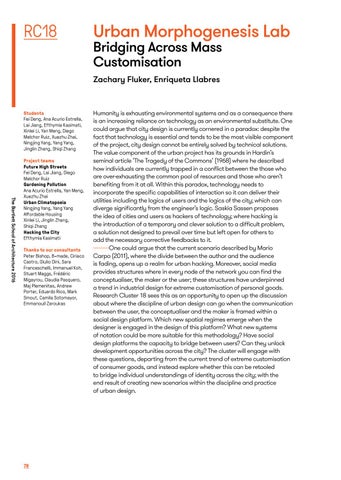RC18
Urban Morphogenesis Lab Bridging Across Mass Customisation Zachary Fluker, Enriqueta Llabres
Students Fei Deng, Ana Acurio Estrella, Lai Jiang, Efthymia Kasimati, Xinlei Li, Yan Meng, Diego Melchor Ruiz, Xuezhu Zhai, Ningjing Yang, Yang Yang, Jinglin Zhang, Shiqi Zhang
The Bartlett School of Architecture 2016
Project teams Future High Streets Fei Deng, Lai Jiang, Diego Melchor Ruiz Gardening Pollution Ana Acurio Estrella, Yan Meng, Xuezhu Zhai Urban Climatopoeia Ningjing Yang, Yang Yang Affordable Housing Xinlei Li, Jinglin Zhang, Shiqi Zhang Hacking the City Efthymia Kasimati Thanks to our consultants Peter Bishop, B-made, Ciriaco Castro, Giulio Dini, Sara Franceschelli, Immanuel Koh, Stuart Maggs, Frédéric Migayrou, Claudia Pasquero, Maj Plemenitas, Andrew Porter, Eduardo Rico, Mark Smout, Camila Sotomayor, Emmanouil Zaroukas
78
Humanity is exhausting environmental systems and as a consequence there is an increasing reliance on technology as an environmental substitute. One could argue that city design is currently cornered in a paradox: despite the fact that technology is essential and tends to be the most visible component of the project, city design cannot be entirely solved by technical solutions. The value component of the urban project has its grounds in Hardin’s seminal article ‘The Tragedy of the Commons’ (1968) where he described how individuals are currently trapped in a conflict between the those who are over-exhausting the common pool of resources and those who aren’t benefiting from it at all. Within this paradox, technology needs to incorporate the specific capabilities of interaction so it can deliver their utilities including the logics of users and the logics of the city; which can diverge significantly from the engineer’s logic. Saskia Sassen proposes the idea of cities and users as hackers of technology; where hacking is the introduction of a temporary and clever solution to a difficult problem, a solution not designed to prevail over time but left open for others to add the necessary corrective feedbacks to it. One could argue that the current scenario described by Mario Carpo (2011), where the divide between the author and the audience is fading, opens up a realm for urban hacking. Moreover, social media provides structures where in every node of the network you can find the conceptualiser, the maker or the user; these structures have underpinned a trend in industrial design for extreme customisation of personal goods. Research Cluster 18 sees this as an opportunity to open up the discussion about where the discipline of urban design can go when the communication between the user, the conceptualiser and the maker is framed within a social design platform. Which new spatial regimes emerge when the designer is engaged in the design of this platform? What new systems of notation could be more suitable for this methodology? Have social design platforms the capacity to bridge between users? Can they unlock development opportunities across the city? The cluster will engage with these questions, departing from the current trend of extreme customisation of consumer goods, and instead explore whether this can be retooled to bridge individual understandings of identity across the city; with the end result of creating new scenarios within the discipline and practice of urban design.
